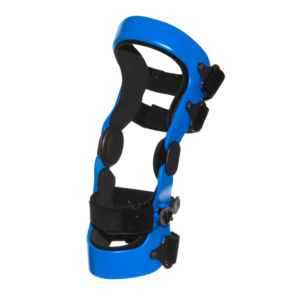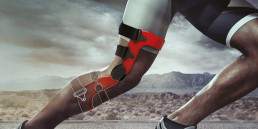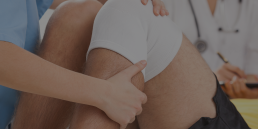Osteoarthritis is one of the most common chronic diseases in Canada, affecting one in ten people. Among these cases, 40% relate to knee osteoarthritis. Many treatments can be considered according to the gravity of symptoms to recover movement and to reduce the impact that osteoarthritis has on a daily basis.
Crippling symptoms
The most telling symptoms of knee osteoarthritis are generally :
- Knee discomfort after change in temperature or during humid weather (mostly in autumn or spring) ;
- Joint stiffness early in the morning or after a long period of stillness, following a progressive loss of flexibility in the knee ;
- Presence of crackling in the knee during flexion ;
- Sensitivity at touch ;
- Pain manifesting when the knee is in movement and eased with rest ;
- Pain occasionally affecting sleep.
Multiple risk factors
Osteoarthritis, also known as gonarthrosis, results from the gradual wear and deformation of the knee joint with damage to the menisci. It is characterized by mechanical pain from friction on joint surfaces, difficulty in performing articular movements, and/or by pain of inflammatory origin (arthritis).
Osteoarthritis (or gonarthrosis) often affects both knees simultaneously and is caused by an accumulation of the following risk factors :
- Age: osteoarthritis is more frequent around the ages of 50 to 60 ;
- Sex: gonarthrosis manifests more often in women, particularly after menopause ;
- Gene factors ;
- Genu varum, a deviation of the axis of the leg with the knees going outwards, or knee algum which consists in a deviation of the axis of the leg with the knees going inwards ;
- Overweight, which overloads the joints ;
- A previous injury in the knee articulation ;
- Repetitive and/or intensive practice of certain activities or sports involving weights causing microtrauma and therefore overworked joints;
- Certain illnesses such as gout, rheumatoid arthritis or infectious arthritis.
Treatments to ease knee osteoarthritis symptoms
There is not one definite treatment of osteoarthritis. Medical care and regular monitoring help to relieve symptoms. First off, wearing an orthosis is the most effective and least invasive solution; knee orthotics have the ability to relieve pain and rehabilitate the joint.
For pain relief, daily analgesics are recommended and can be prescribed by your doctor. In the most serious cases, the installation of a knee prosthesis by surgery may be considered. Thanks to the use of an orthosis, the risk of serious surgery can be delayed. In any case, consulting with your doctor is a necessary step towards making the right diagnosis and prescribing the best treatment.
To prevent risks of osteoarthritis, it is possible to fight its main aggravating factors. It is therefore recommended to adopt a healthy and balanced diet, to exercise regularly and to limit any form of daily pressure applied on your joints.
Orthotists at Laboratoire EVO offer you personalized advice and customize the best knee orthotics to match your diagnosis. We use 3D scanners to make the measurements and moulding necessary for orthotics ensuring optimal comfort and the most precise fit.
Share this article
Related posts
February 9 2021
Benefits of Orthosis Made by 3D Printing
April 14 2018
New Treatments Against Osteoarthritis
Unsteadiness, vertigo, persistent sensation of fall, these symptoms are often the cause...


